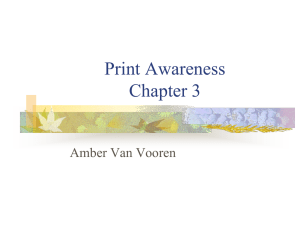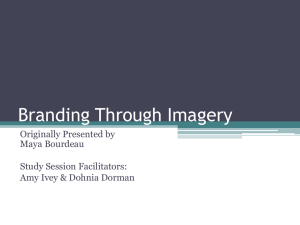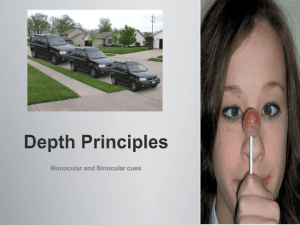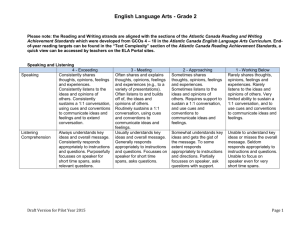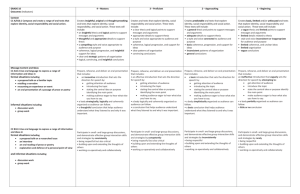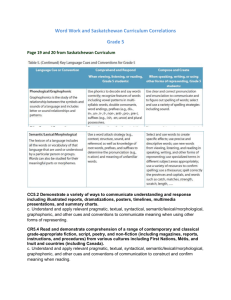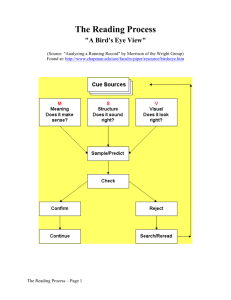ELA 2 Language Cues Conventions
advertisement
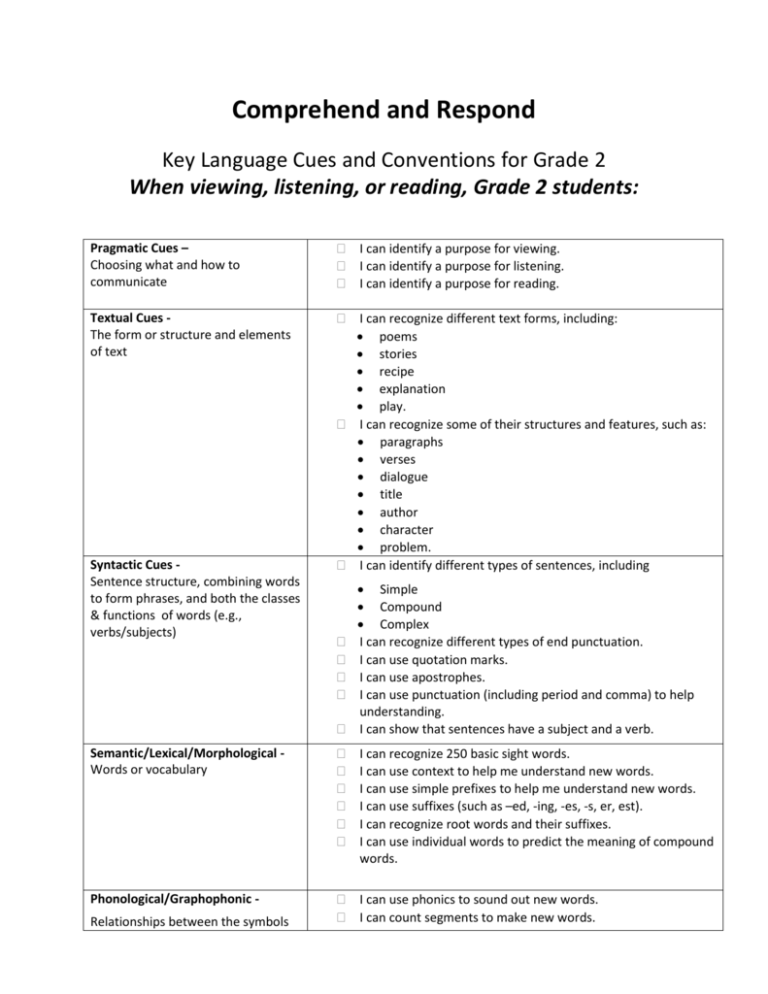
Comprehend and Respond Key Language Cues and Conventions for Grade 2 When viewing, listening, or reading, Grade 2 students: Pragmatic Cues – Choosing what and how to communicate Textual Cues The form or structure and elements of text Syntactic Cues Sentence structure, combining words to form phrases, and both the classes & functions of words (e.g., verbs/subjects) I can identify a purpose for viewing. I can identify a purpose for listening. I can identify a purpose for reading. I can recognize different text forms, including: poems stories recipe explanation play. I can recognize some of their structures and features, such as: paragraphs verses dialogue title author character problem. I can identify different types of sentences, including Simple Compound Complex I can recognize different types of end punctuation. I can use quotation marks. I can use apostrophes. I can use punctuation (including period and comma) to help understanding. I can show that sentences have a subject and a verb. Semantic/Lexical/Morphological Words or vocabulary I can recognize 250 basic sight words. I can use context to help me understand new words. I can use simple prefixes to help me understand new words. I can use suffixes (such as –ed, -ing, -es, -s, er, est). I can recognize root words and their suffixes. I can use individual words to predict the meaning of compound words. Phonological/Graphophonic - I can use phonics to sound out new words. I can count segments to make new words. Relationships between the symbols and sounds of a language (e.g. letter or sound relationships and patterns) Other Cues and Conventions Other cues and conventions are also found in communication acts and include such elements as graphics, layout, colour, sound, movement, font choices, and handwriting. I can explore blend phonemes at the beginning of new words (such as sk, ch, sh). I can recognize and use the alphabet. I can delete beginning and ending sounds and tell the remaining word (root word). I can use phonics to help understand multi-syllable words. I can use possessive. I can recognize double vowels and the sounds they make. I can recognize long vowel sounds. I can use contractions. I can use “y” as a vowel sound. I can recognize consonant clusters. I can recognize and read consonant digraphs. I can interpret and respond to non-verbal cues such as facial expressions and gestures. I can recognize features of different texts such as: Pictures Graphics Diagrams Bold Type Labels Headings Sounds Colours CR2.4 Read and demonstrate comprehension of grade-appropriate literary and informational texts read silently and orally by relating and retelling key events and ideas in sequence with specific details and discussing how, why, and what if questions. c. Understand and apply the appropriate cues and conventions (pragmatic, textual, syntactical, semantic/lexical/morphological, graphophonic, and other) to construct and confirm meaning when reading. Compose and Create Key Language Cues and Conventions for Grade 2 When speaking, writing, or using other forms of representing, Grade 2 students: Pragmatic Cues – Choosing what and how to communicate Textual Cues The form or structure and elements of text Syntactic Cues Sentence structure, combining words to form phrases, and both the classes & functions of words (e.g., verbs/subjects) I can explore what and why something needs to be communicated. I can work with my teacher to explore different forms to share my ideas (e.g story, dramatization, letter). I can present my ideas in logical sequence. I can add details to my ideas. I can use and write simple complete sentences with detail (in speech, 7.3; in writing, 7.0 words by June). I can recognize the verb and the subject in a sentence. I can use simple connecting words (and, so, but, then). I can use a variety of sentence types (statements, questions, exclamations). I can use both adjectives and adverbs to add description. I can use negative correctly. I can use capitals: at the start of sentences with names with months with places. I can use the question mark correctly. I can use the comma correctly. I can choose and use words to add interest or to clarify. I can find and use special words like: alliteration onomatopoeia I can substitute words (e.g. building for house). I can use conventional Canadian spelling. I can begin to use resources like the word wall and my personal dictionary. I can correctly spell The name of my town days of the week months I can spell high-frequency words such as: stop, shop, drop., see, saw … Semantic/Lexical/Morphological Words or vocabulary Phonological/Graphophonic Relationships between the symbols and sounds of a language (e.g. letter or sound relationships and patterns) Other Cues and Conventions Other cues and conventions are also found in communication acts and include such elements as graphics, layout, colour, sound, movement, font choices, and handwriting. I can use phonics to spell unfamiliar words (e.g. words ending in –ing, words with more than one syllable). I can use long and short vowel patterns. I can use –es to form plurals of some words. I can understand that the same sound may be represented by different spellings (e.g. find, phone). I can communicate ideas and needs by: using simple gestures adjusting the volume of my voice adjusting the tone of my voice. I can speak and oral read: in a loud, clear voice using appropriate volume using good pace using good expression. I can print legibly. I can space letters, numbers, words and sentences appropriately. I can hold my pencil appropriately. CC2.2 Use a variety of ways to represent understanding and to communicate ideas, procedures, stories, and feelings in a clear manner with essential details. c. Understand and apply the appropriate cues and conventions (pragmatic, textual, syntactical, semantic/lexical/morphological, graphophonic, and other) to construct and communicate meaning when using other forms of representing.

